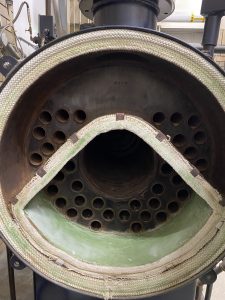54 Boiler Details
Learning Objective
Describe the construction and operation of boilers.
Essential Question
What are the different type of boilers, and how do they work?
Introduction
One crucial aspect of HVAC systems is the utilization of boilers, which play a central role in heating applications across various industries. In this course, we will embark on a journey to understand the different types of boilers and their operation, exploring their functions, components, and operational principles. Through detailed study and practical insights, you will gain the knowledge and skills necessary to excel in the dynamic field of HVAC.
Watertube Boilers
Definition: “these tubes have water circulating inside the tube with heat being applied to the outside” (PanGlobal, 2017)
Watertube boilers are widely used in power plants and refineries because they operate under high pressure, using a design where water circulates through tubes to absorb heat from hot gases produced during combustion. This design, considered an industry standard, offers advantages like safety due to lower water content and quick adaptation to workload changes.
Despite their common use in big industries, watertube boilers are not commonly chosen for smaller heating setups with low-pressure steam needs. The main reasons are their higher cost compared to alternatives like cast-iron or steel firetube boilers, and the extra attention required, especially for water treatment.
However, specialized watertube steam heating boilers are designed for low-pressure heating needs and are typically available as complete, pre-packaged units. This tailored design aims to address the specific requirements of low-pressure heating applications.
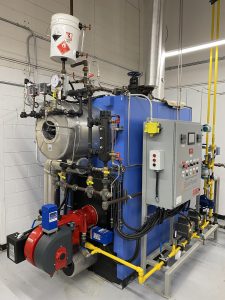
Key Functions
- Water Circulation: Watertube boilers have a network of tubes, typically serpentine-shaped, through which water circulates. This allows for efficient heat transfer due to the large surface area of the tubes.
- Combustion: A fuel source, such as natural gas, oil, or coal, is burned in a combustion chamber. The heat generated during combustion is transferred to the surrounding water in the tubes.
- Heat Absorption: As the water circulates through the tubes, it absorbs the heat from the combustion gases. This absorption causes the water temperature to rise, eventually converting it into steam.
- Steam Generation: The absorbed heat causes the water to undergo a phase change, transforming it into steam. The steam rises to the upper part of the boiler, typically collected in a steam drum or chamber.
- Pressure Control: Watertube boilers can operate at different pressure levels. The pressure is controlled based on the specific requirements of the application.
- Distribution of Steam: The generated steam can be used for various purposes, such as heating buildings, powering turbines for electricity generation, or supporting industrial processes.
- Efficiency and Safety: Watertube boilers are designed for efficiency in heat transfer and often include safety features, such as pressure relief valves, to ensure safe operation.
Construction
A common kind of watertube boiler is the following. Watertube boilers are made of two parts: a lower and upper head which are both connected using by many tubes made of copper or steel using threaded connections. See below an image of a low-pressure watertube boiler.
- Tubes: Watertube boilers consist of a series of tubes, often serpentine in shape, through which water circulates. These tubes are made of materials such as steel or copper alloy and are arranged to maximize the surface area for heat transfer.
- Headers: Headers are large pipes located at the ends of the tubes. The lower header collects the water, while the upper header distributes the steam. Headers provide a pathway for the fluid (water or steam) to move through the system.
- Drum or Steam Drum: A steam drum is often incorporated into the design to collect and store the generated steam. It acts as a reservoir, ensuring a consistent supply of steam is available for distribution.
- Combustion Chamber: This is the area where fuel, such as natural gas or oil, is burned. The combustion chamber is strategically positioned to surround the tubes, allowing efficient transfer of heat to the circulating water.
- Burners: Burners are responsible for igniting and combusting the fuel within the combustion chamber. The design and configuration of burners vary based on the type of fuel used.
- Insulation: The entire boiler is typically enclosed by insulation material to minimize heat loss and improve overall efficiency.
- Safety Features: Low-pressure watertube boilers are equipped with safety features such as pressure relief valves, which release excess pressure to prevent potential hazards. Other safety devices may include water level indicators and alarms.
- Control Systems: Modern low-pressure watertube boilers are often equipped with sophisticated control systems to regulate factors like fuel input, water flow, and pressure levels for optimal performance.
- Support Structure: The boiler is mounted on a sturdy support structure, ensuring stability and facilitating installation.
- Piping and Valves: Various pipes and valves connect different parts of the boiler, allowing for the controlled flow of water, steam, and other fluids.
It’s important to note that specific designs may vary based on the manufacturer and intended application. Additionally, adherence to safety codes and regulations is critical in the construction of low-pressure watertube boilers to ensure reliable and secure operation.
Cast-Iron Sectional Boilers
Definition: A cast-iron sectional boiler is a durable heating unit assembled from individual cast-iron sections, commonly used for reliable and efficient heating in various settings.
A cast-iron sectional boiler is a type of boiler commonly used for heating applications. It is constructed from individual cast-iron sections that are bolted or otherwise assembled together to form the boiler unit. Each section typically contains a portion of the heating surface and water chamber.
These boilers are known for their durability and efficiency in providing a consistent and reliable source of heat. The cast-iron construction allows for better heat retention and even distribution, contributing to their effectiveness in heating spaces such as residential buildings, commercial establishments, and industrial facilities.
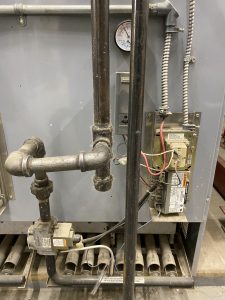
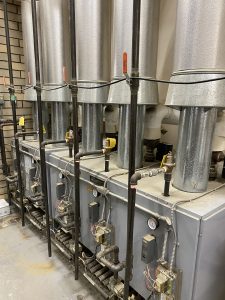
Key Functions
- Efficient Heat Production: Generates heat through the combustion of fuel within the individual cast-iron sections.
- Even Heat Distribution: Utilizes the cast-iron construction to evenly distribute heat, ensuring consistent warmth throughout the heating system.
- Durability: The cast-iron material provides robustness, withstanding the rigors of heating processes and environmental conditions.
- Reliability: Known for dependable and long-term operation, providing a consistent source of heat for various applications.
- Maintenance: Maintenance workers inspect, troubleshoot, and perform routine tasks to ensure the boiler’s optimal performance, including checking for signs of wear, addressing corrosion, and maintaining proper water levels.
Construction
A cast-iron sectional boiler is like a building made from Lego-like blocks. Each block, or section, is made of strong cast iron and has its own job. Here’s a simple breakdown of its construction and important components:
- Sections: Imagine the boiler as a stack of blocks. Each block, or section, is like a mini house with its own walls and a roof. These sections are usually bolted together to form the complete boiler.
- Combustion Chamber: Inside each section, there’s a space called the combustion chamber. This is where we create heat by burning fuel, like gas or oil.
- Water Chamber: There is a dedicated space within each individual section where water is stored and heated. It’s like a small reservoir or bathtub within each block of the boiler. The primary purpose of the water chamber is to absorb and retain the heat generated in the combustion chamber.
- Bolts: The sections are held together by bolts, similar to screws holding building blocks together.
- Pipes: Similar to connecting corridors, pipes link all sections, facilitating the movement of water and steam to ensure uniform heating.
- Burners: These are like the burners on your kitchen stove. They start the fire in the combustion chamber, creating the heat we need.
- Insulation: Insulation functions as a protective covering, resembling a snug blanket around the boiler. Its role is to preserve heat within, thereby optimizing the boiler’s efficiency.
Manhole:
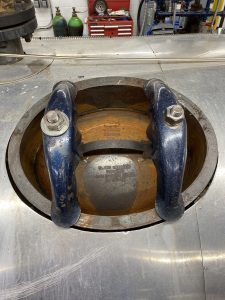
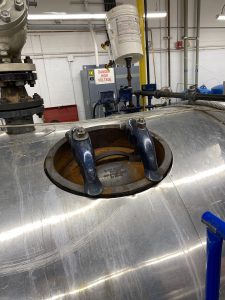
Handhole:
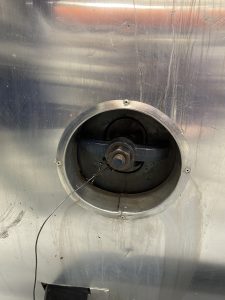
For more details of the construction, watch this video.
Understanding the design and functioning of cast-iron sectional boilers is essential for effective maintenance and safe operation.You may need to observe a cast-iron sectional boiler to check for the following:
- Check for corrosion
- Ensure proper water levels
- Inspect and clean burners
- Inspect individual sections of the boiler
Cast-Iron Modular Boilers
Definition: A cast-iron modular boiler is a versatile heating system made of separate modules, each with its own combustion and water chambers. These modules can be stacked to meet specific heating requirements in larger settings.
A cast-iron modular boiler in a commercial building plays a crucial role in delivering efficient, scalable, and customizable heating solutions while maintaining durability, reliability, and adaptability to changing building dynamics.
Key Functions
Construction
The construction of cast-iron modular boilers involves a design that allows for flexibility and scalability. Here are the key components and aspects of their construction:
- Modular Units: Cast-iron modular boilers consist of separate modules, each acting independently with its combustion and water-containing chamber.
- Cast Iron Construction: These modules are made of cast iron, chosen for durability, heat retention, and corrosion resistance.
- Combustion Chamber: Each module has its combustion chamber, where fuel is burned to generate heat.
- Water-Containing Chamber: Adjacent to the combustion chamber, a chamber holds water, heated by combustion to produce steam for heating.
- Independence and Connectivity: Modules operate independently but can be connected or stacked, offering adaptability.
- Scalability: Additional modules can be added as needed, suitable for varying heating requirements in commercial applications.
- Insulation: Modules are insulated to minimize heat loss, ensuring optimal energy efficiency.
- Control Systems: Equipped with advanced control systems regulating fuel input, water flow, and temperature for precise heating control.
- Piping and Connectors: Units are connected through piping, enabling water or steam movement for uniform heat distribution.
- Support Structure: Sturdy support structures mount the modules, ensuring stability and facilitating installation.
The modular design offers flexibility, scalability, and adaptability to meet the specific heating needs of commercial applications.
Cast-Iron Sectional vs. Modular Boilers
Key Differences
- Assembly: Sectional boilers are assembled by connecting cast-iron sections, while modular boilers consist of separate modules that can be combined.
- Flexibility: Modular boilers offer more flexibility in terms of configuration and scalability, making them suitable for larger and more complex heating systems.
- Applications: Sectional boilers are commonly used in smaller-scale residential and light commercial settings, while modular boilers are preferred in larger commercial and industrial settings.
In summary, the main distinction lies in the way the components are assembled and the scale of applications they are designed for, with sectional boilers being more common in smaller setups and modular boilers providing flexibility for larger and more demanding heating systems.
Firetube Boilers
Definition: “these are the smaller diameter cylindrical tubes through which the flue gas travels inside and are surrounded by water on the outside” (PanGlobal, 2017, 3-2)
A firetube boiler is a heating system that utilizes tubes to transfer heat through the combustion of fuel. Here’s a breakdown of its role:
Key Functions
- Heat Generation: The firetube boiler produces heat by burning fuel, commonly gas or oil, within tubes.
- Functionality in Commercial Buildings: It serves as a crucial component for maintaining comfortable temperatures in commercial spaces.
- Simplified Maintenance: The design of firetube boilers often allows for straightforward maintenance procedures. Accessible components and a clear layout facilitate easy inspection and repair tasks.
- Reliability: Firetube boilers are known for their reliability, providing a consistent source of heat to ensure the building’s comfort.
- Temperature Control: They offer precise temperature control, allowing users to adjust and maintain the desired temperature levels.
- Energy Efficiency: Contributing to the overall energy efficiency of the building, firetube boilers support cost-effective and environmentally friendly operations.
- Durability and Longevity: Constructed with durability in mind, firetube boilers have a robust design to withstand continuous use, provided they undergo proper maintenance.
- Ease of Repair: Their design simplifies the repair process, making it easier to identify and address issues promptly.
- Adaptability: Firetube boilers can adapt to varying heating requirements, offering flexibility in commercial building applications.
- Integration with Building Systems: They integrate seamlessly with building management systems, allowing for centralized control and monitoring.
- Safety Compliance: Firetube boilers adhere to safety standards, ensuring secure operation and compliance with regulations for the well-being of occupants and the building.
Construction
The firetube boiler involves key components designed for efficiency and accessibility. Here’s an overview:
- Shell: The main body, or shell, houses the water and the tubes. It is typically cylindrical in shape.
- Tubes: Tubes run through the shell and carry hot gases produced by the combustion process. These tubes transfer heat to the water surrounding them.
- Furnace: The furnace is where the fuel is burned to generate hot gases. It is usually located within the shell, surrounded by the water-filled tubes.
- Front and Rear Heads: The front and rear heads close the ends of the shell, creating a contained space for combustion and heat transfer.
- Access Doors: The boiler features access doors, facilitating easy entry for maintenance and repair tasks. These doors provide accessibility to the internal components.
- Burner: The burner is responsible for the combustion of fuel within the furnace, producing hot gases.
- Grates: Grates support the fuel during combustion and allow the ashes to fall away, aiding in maintenance and cleanliness.
- Water Space: This is the area within the shell where water is stored and surrounds the tubes to absorb heat.
- Steam Space: The upper portion of the shell, above the water space, is dedicated to the production and collection of steam.
- Manholes: Manholes are openings in the shell, usually covered with a removable plate, providing access for inspection and maintenance.
- Insulation: The boiler may be insulated to minimize heat loss, improving efficiency. Insulation also aids in safety by preventing burns.
- Safety Valves: Safety valves release excess pressure to prevent potential hazards. These are critical components for the safety of the system.
- Piping: Piping facilitates the movement of water, steam, and gases within the boiler system.
Manhole:
For more information and details about parts, watch the following video.
Electric Boilers
Definition: Unlike water and fire boilers, electric boilers use energy from an electrode or an element in order to generate heat. Electric boilers are used for larger buildings such as schools, hospitals, etc. (PanGlobal, 2017).
“They provide steam for heating, sterilizing, laundry, and kitchen equipment” (PanGlobal, 2017, 4-2).
It is important to understand the function and construction of all boiler types in order to choose one that is most effective in use and cost.
Key Functions
- Heating: Electric boilers efficiently provide heat for commercial spaces, contributing to a comfortable environment.
- Sterilization: They play a crucial role in sterilizing equipment and maintaining hygienic conditions, especially in industries with stringent cleanliness requirements.
- Laundry Operations: Electric boilers are essential for generating steam used in laundry facilities, ensuring effective cleaning and sanitation.
- Kitchen Equipment: They power steam-based kitchen equipment, facilitating cooking processes and contributing to the overall functionality of commercial kitchens.
- Temperature Control: Electric boilers allow precise control over temperatures, ensuring optimal conditions for various commercial applications.
- Versatility: They offer versatility in application, adapting to diverse heating requirements in commercial settings.
- Energy Efficiency: Electric boilers can be energy-efficient, supporting cost-effective and environmentally friendly operations.
- Ease of Maintenance: Their design often facilitates ease of maintenance, allowing for straightforward inspection and repair procedures.
- Reliability: Electric boilers provide a reliable source of steam, contributing to consistent performance in commercial operations.
- Safety Features: Modern electric boilers often come with safety features, ensuring secure operation in compliance with industry standards and regulations.
Construction
The construction of an electric boiler in a commercial setting typically includes the following key components:
- Heating Elements: Electric boilers have heating elements, usually made of materials with high electrical resistance, such as nickel-chromium alloy. These elements convert electrical energy into heat.
- Water Storage Tank or Vessel: Commercial electric boilers often feature a water storage tank or vessel where water is stored and heated to produce steam.
- Control Panel: An integral part of the construction is the control panel, which houses the electrical controls for managing the boiler’s operation, temperature, and safety features.
- Safety Features: Electric boilers incorporate safety features such as pressure relief valves and temperature controls to ensure secure and compliant operation.
- Piping System: A piping system facilitates the movement of water or steam within the boiler and to various points of use in the commercial facility.
- Insulation: Some electric boilers are equipped with insulation to minimize heat loss and improve overall energy efficiency.
- Digital Display or Interface: Many modern electric boilers include a digital display or user interface for monitoring and adjusting settings.
- Expansion Tank: An expansion tank is often included to accommodate changes in water volume due to temperature variations, preventing excessive pressure buildup.
- Safety Shut-Offs: Electric boilers have safety shut-offs that activate in case of malfunctions, ensuring safe operation.
- Mounting Structure: A sturdy mounting structure supports the various components of the electric boiler.
- Flanges and Connectors: Flanges and connectors provide points for the attachment of pipes, allowing for the distribution of steam or hot water.
- Diagnostic Systems: Some electric boilers may incorporate diagnostic systems for identifying issues and streamlining maintenance.
- Drain Valve: A drain valve facilitates the removal of sediments or maintenance-related tasks.
Drain Valve:
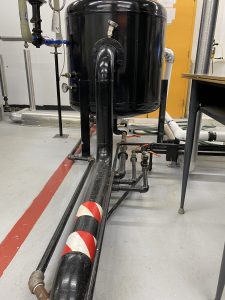
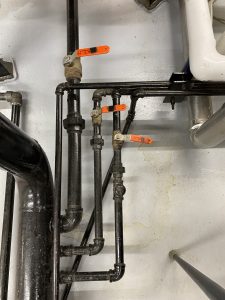
For more information about how an electric boiler works, watch the following video.
Advantages and Disadvantages
| Advantages | Disadvantages |
| Electric boilers are very compact as they do not require furnace space for combustion, and therefore do not require ductwork or a chimney. | The main disadvantage of the electric boiler is the usually high comparative cost of the required electricity. |
| No fuel storage space is required as in the case of oil-fired or coal-fired boilers. | Most designs are limited in pressure to about 2100 kPa (304 psi), due to the effect of high temperature on the electrodes or elements. |
| Electric boilers are quickly and easily installed due to the fact that ductwork, chimneys, and fuel lines are not required. | |
| A high percentage (98%) of the energy delivered by the electricity is absorbed as heat in the boiler. | |
| Electric boilers produce no pollution such as smoke, dust, ashes, etc. It is true, however, that the generating plant which originally produces the electrical power will no doubt produce some of the pollutants mentioned unless it is a hydroelectric plant. | |
| Electric boilers are silent in operation and are safe because there is no possibility of furnace explosion. | |
| With fuel boilers, metal temperatures ca become considerably higher than the water temperature. This causes scale-forming dissolved solids to strongly adhere to the metal. With electric boilers, the metal surfaces never get hotter than the water temperature, so any dissolved solids tend to end up as sludge rather than scale. | |
| Another major consideration is damage caused by low water level. In the electrode boiler this is not a concern since in the event of low water, electric current ceases to flow, thus no heat is generated. | (PanGlobal, 2017, 4-3) |
Conclusion
It is very important to understand the function and parts of each type of boiler to make an informed decision on which boiler is the most appropriate to use. Maintenance Repair Workers should be familiar with each type in order to operate and repair these boilers.
Ensure you have read through the entire section, watched all the videos, and completed all the activities.
Copyright © 2017 PanGlobal. All rights reserved. Under Fair Use Policy.
PanGlobal. (2017). In Boiler Details. Low Pressure Boiler Components & Operation (2nd ed.). PanGlobal Training Systems Ltd.

